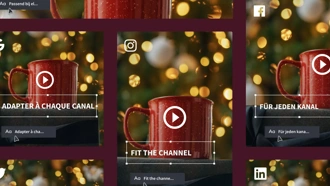It goes without saying that your logo needs to make a good first impression. It’s the first thing your customers see. However, if it has been around for a while, it may have lost that cutting-edge look and feel it once had; or perhaps it was created when time and resources were scarce, and now your business needs a logo that reflects its current state. How do you know it’s the right time to redesign your company’s logo? Consider these points:
- Your company has expanded well beyond the ideas conveyed by the original logo.
- The logo looked great when your marketing materials were all printed, but it hasn’t adapted to the digital age well.
- You created it yourself, or had someone do it cheaply, and it shows.
- Even though your company has grown and expanded, your logo is too complex to convey the brand’s basic essence.
- Your top five competitors have logos that are better than yours.
1. It Won’t Be Easy (Nor Cheap)
Be prepared to set aside a budget and a timeline. How much, however, depends on the size of your business and how much time and money you can afford to invest in brand management. A small business could expect costs in the thousands of dollars and a timeline that lasts a few weeks at most. A large enterprise could expect millions (even hundreds of millions) of dollars spent, along with several months of time, which means the stakes are even higher.
Make sure you consider every place the new logo will be used: printed collateral, billboards, your web site, TV ads, emails, social media, and so forth. The image should easily scale between all those environments, so it looks just as good whether it’s 40 stories or 40 pixels high.
Also, remember that the implementation process can cost much more than redesigning a logo, because so many stakeholders and touchpoints will be affected by the change. We’ll cover the implementation process in section eight.
2. Think About the Essence of Your Company
What does your company do? Don’t answer that question as a basic description of the products and/or services your business sells. The correct response involves the deep-in-your-bones essence of the business, such as, you give families memories they’ll savor forever, or you solve a pain point that’s been perplexing companies for decades. Your logo needs to reflect this message and capture your brand’s essence.
How do you ensure it does that? You’ll need to ask yourself and your team plenty of questions when you get started:
If you had to describe your company in one word, what would it be? What single word would your customers use?
Why does your business use the colors and typefaces that it does?
Who is your target audience? Is it possible they will change in the coming months or years?
How well do your competitors logos convey the essence of their brand?
3. Keep it Simple
You’ve seen the articles examining why simple, iconic logos like Apple, Nike, McDonalds, and others continue to resonate: they convey the essence of the brand with as few elements as possible. (Consider how adding a bite to the Apple logo brilliantly added a layer of meaning, and look at the company’s original logo (not the striped apple one) to see how Apple executed its own successful logo redesign.)
Make sure your logo keeps it simple too, not only because you want it to be memorable and you need it to be easier to reproduce at different sizes, and in different media.
You may want to consider taking the name off the logo, like some big brands have done, but only if you’re continuing the theme of the original logo, so consumers will still recognize it. (Even if your brand occupies a niche, you can get away with this if the original logo is well-known among your fans.)
4. You Don’t Want to Do This Again in a Few Years
Think about timelessness. You want a logo that will still be relevant years and decades from now. Forget about today’s trends and gimmicks and focus on a look and feel that people will respond to in positive ways years or even decades from now. You also won’t be accused by anyone of trying to ride the coattails of some fad and get short-term gain out of it.
5. This is Your Chance to Differentiate From the Competition
Look at the logos your competitors are using and then figure out how to stand out next to their images by going against what they’re doing. For example, think about the elements that make good logos attractive in your industry – curved lines, for example – and incorporate them in your own way, so your logo will make sense when viewed next to others while standing out on its own.
6. Get Input From as Many People as Possible
Don’t limit input to employees. Get feedback from customers and others too. As we discussed in our rebranding how-to, it also wouldn’t hurt to adopt the mindset of a teenage boy. That is, make sure your logo is foolproof, with no room to be mistaken for something lewd. The last thing you want is a slew of juvenile commentary.
7. Don’t Change Everything at Once
The worst logo redesigns typically try to change everything at once: the color scheme, the font used, the imagery, and so forth. Don’t be like them, unless your situation demands a complete makeover. Instead, refresh a couple elements and see how that goes over during the feedback stage. Then you can refine and try to change a few more things, if you want.
8. Put Together a Rollout Plan & Stick to It
If the logo redesign is part of a wider rebranding, make sure it’s integrated into that process everywhere possible. If you’re not doing a complete rebranding, think about the ways you’ll roll out the new logo for maximum impact. You don’t need to present it to your customers and the wider public all at once – maybe you’ll want to do a “soft rollout” on your website first, just to gauge initial reactions, and then go wide afterward.
However you decide to handle it, make sure you have a detailed communication plan in place, one that’s proactive and has all employees on board. That way, no matter how and where the criticisms arrive, your company will respond with a united front.
As mentioned earlier, the implementation process can be the most expensive and time consuming part of redesigning a logo.
9. Know When to Cut Your Losses
If there’s backlash against your new logo (and if it happens, it will be swift in this social media age), take all the comments to heart and make a tough decision: try again with the feedback in mind, or simply go back to the old logo. If you’re going to change it again, though, think long and hard first and don’t do another logo redesign after that – you’ll just dig yourself into a deeper hole if you keep changing the logo.
Learn more about how Bynder can help your brand. Book a demo today.












